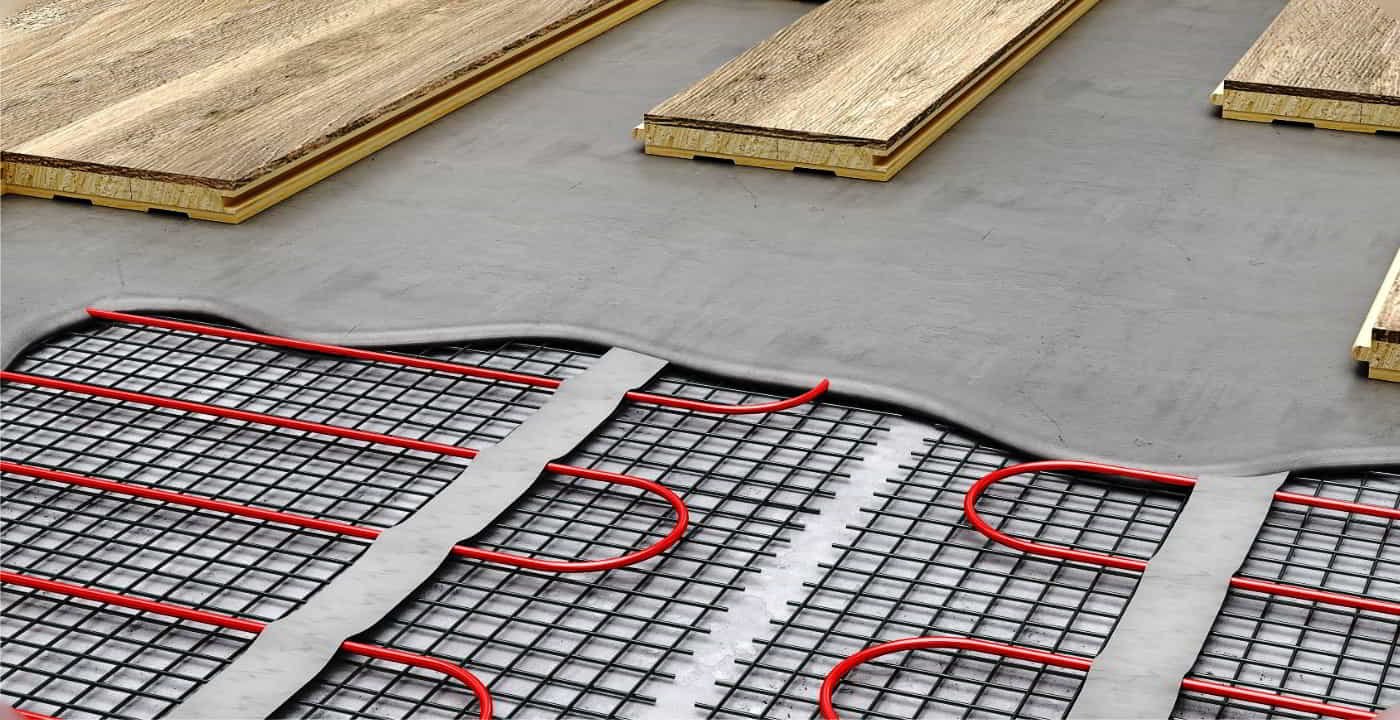Short on Time? Here are the Key Notes
- Radiant floor heating offers competitive pricing, low installation costs, and energy efficiency, potentially saving homeowners up to 30% compared to forced air systems.
- Unlike forced air systems, radiant floor heating operates silently and does not circulate dust, providing a clean and allergen-free environment.
- Radiant heating evenly distributes heat across the room, ensuring consistent comfort without any “hot spots” commonly found with forced air systems.
What is Radiant Floor Heating?

Radiant floor heat systems involve the use of warm water or electric heating elements, and are installed beneath the floor surface.
The heat radiates upward, providing even and consistent warmth throughout the room. This heating method is often considered luxurious, providing a comfortable and cozy environment during cold winter months.
Read on to discover the underfloor heating pros and cons.
Pros of Radiant Floor Heating
Energy Efficiency
Radiant floor heating is highly energy efficient. Instead of heating and circulating air, it directly warms the floor, objects, and people in the room. This eliminates the energy loss associated with forced air systems, where heat can escape through ducts or be wasted by warming unused spaces. The direct heat transfer of radiant floor heating results in lower energy bills and overall energy efficiency.
Comfort
One of the key advantages of radiant floor heating is the consistent warmth it provides. The radiant heat emitted from the floor creates a comfortable environment without creating drafts or hot spots.
Unlike forced air systems, which can create uneven heating and temperature variations, radiant floor heating ensures a pleasant and even distribution of heat throughout the room.
Quiet Operation
In floor heating systems operates silently, enhancing the overall comfort of the living space. There are no fans or blowers involved, eliminating the noise typically associated with forced air systems.
This absence of noise contributes to a peaceful and serene environment, allowing occupants to enjoy their living spaces without disruptions.
Allergen Reduction
Radiant floor heating is an excellent choice for individuals with allergies or sensitivities. Unlike forced air systems, which blow air and circulate dust, allergens, and other particles, radiant floor heating does not rely on forced air movement.
As a result, it significantly reduces the circulation of dust, allergens, and other airborne particles, contributing to improved indoor air quality and creating a cleaner and healthier living environment.
Design Flexibility
With radiant floor heating, the heating elements are hidden beneath the flooring. This design allows for more freedom and flexibility in interior design and furniture placement.
Unlike forced air systems that require visible vents or radiators, radiant floor heating provides a seamless and unobtrusive heating solution, enabling homeowners to fully utilize their space and create the desired aesthetic appeal without any limitations posed by visible heating systems.
Durability
The components of radiant floor heating systems are known for their durability and longevity. When properly maintained, they can last for many years.
Regular inspections and maintenance, such as checking for leaks and ensuring the proper functioning of the system, can help extend the lifespan of the system even further. The durability of radiant floor heating systems ensures long-term reliability and performance.
Cons of Radiant Floor Heating
Here we will discuss the disadvantages of radiant floor heating so you can be aware of some of the drawbacks.
Higher Installation Cost
One of the main drawbacks of radiant floor heating is its higher upfront cost compared to forced air heating systems.
The installation of radiant floor heating involves laying down the heating elements or tubing beneath the flooring, which can be a labor-intensive and time-consuming process. The complexity of installation contributes to the higher initial investment required.
Slower Heating
Radiant floor heating takes longer to heat up the room compared to forced air systems. The heat emitted from the floor gradually warms the space, making it more suitable for consistent and prolonged heating rather than quick bursts of warmth.
This slower heating process may not be ideal for those who desire immediate warmth upon turning on the heating system.
Limited Cooling Options
Radiant floor heating systems are primarily designed for heating purposes and may not have built-in cooling capabilities.
This means that separate cooling systems, such as air conditioning units or fans, would be required to cool the space during warmer months. Homeowners should consider this limitation and plan accordingly if they desire both heating and cooling functionalities in their home.
What is Forced Air Heating?

Forced air heating is a common heating system that uses heated air blown through ducts to warm the living space. This method distributes warm air quickly and effectively, providing a rapid increase in temperature throughout the room. Now we’ll discuss the pros and cons of forced air heating.
Pros of Forced Air Heating
Here are the benefits of forced air heating, where we’ll discuss why this heating system may be the right choice for your home:
Quick Heating
Forced air heating systems excel at quickly raising the temperature in a cold space. The heated air is blown through the ducts and distributed rapidly, resulting in a rapid increase in temperature throughout the room. This makes forced air heating ideal for situations where immediate warmth is desired.
Cooling Capabilities
Many forced air heating systems include built-in air conditioning, providing both heating and cooling functions in one system.
This integrated cooling capability offers convenience and flexibility, allowing homeowners to maintain a comfortable temperature throughout the year without the need for separate cooling systems.
Lower Upfront Cost
One of the advantages of forced air heating systems is their lower upfront cost compared to radiant floor heating systems.
Forced air systems utilize ductwork, which is commonly installed in homes, making the installation process more straightforward and cost-effective. This lower initial investment can be appealing for homeowners on a budget.
Wide Availability
Forced air heating systems are widely available, making them easier to install and repair. HVAC professionals are experienced in working with forced air systems due to their prevalence, which means that homeowners can easily find qualified technicians for installation, maintenance, and repairs. The wide availability of forced air systems contributes to their convenience and accessibility.
Cons of Forced Air Heating
Inconsistent Heat Distribution
One of the drawbacks of forced air heating systems is the potential for inconsistent heat distribution. The forced air can create drafts and temperature variations within the room, leading to uneven heating.
Certain areas may feel warmer than others, while some spots may experience cooler temperatures. This inconsistency in heat distribution can result in discomfort for occupants and may require adjustments to achieve desired comfort levels.
Noise
Forced air systems can produce noise during operation, particularly when the air is forcefully pushed through the vents. The sound of air moving through the ducts, the operation of the blower fan, and the opening and closing of registers can contribute to the overall noise level in the home.
This noise can be disruptive and may affect the tranquility of the living space, especially in quiet environments or during nighttime.
Reduced Indoor Air Quality
The circulation of air in forced air heating systems can contribute to the distribution of dust, allergens, and pollutants throughout the home. As the system pushes air through the ducts, any contaminants present in the ductwork can be carried along and dispersed into the living spaces.
This can potentially affect indoor air quality, particularly for individuals with respiratory conditions or allergies.
Energy Loss
Forced air systems can experience energy loss through duct leaks. Leaky ducts can allow heated air to escape into unconditioned spaces such as attics, crawl spaces, or walls, resulting in energy waste.
This energy loss can reduce the overall energy efficiency of the heating system, leading to higher energy bills and a less environmentally friendly solution. Regular maintenance and inspections are essential to identify and repair any duct leaks to optimize energy efficiency.
Comparison of Radiant Floor Heating and Forced Air Heating

Both radiant floor heating and forced air heating have their own advantages and disadvantages. Here is a detailed comparison of the two heating systems:
| Comparison Factor | Radiant Floor Heating | Forced Air Heating |
|---|---|---|
| Energy Efficiency | High energy efficiency due to direct heat transfer | Moderate energy efficiency due to energy loss in ducts |
| Comfort | Consistent and gentle heat distribution | Quick heating, but potential for drafts and temperature variations |
| Indoor Air Quality | Reduced circulation of dust and allergens | Potential for increased dust and allergen distribution |
| Installation Cost | Higher upfront cost | Lower upfront cost |
| Cooling Capabilities | Usually requires a separate cooling system | Many systems include built-in air conditioning |
| Design Flexibility | Hidden beneath the floor, more design freedom | Visible vents may impact interior design choices |
| Noise | Silent operation | Possible noise from fans and air movement |
| Lifespan | Long-lasting with proper maintenance | Lifespan depends on system components and maintenance |
| Energy Loss | Minimal energy loss as heat is directly radiated | Potential energy loss through leaks in ducts |
Energy Efficiency: Which System is More Efficient?
When it comes to energy efficiency, radiant floor heating holds an advantage over forced air heating. Radiant floor heating systems transfer heat directly to the floor, objects, and people, minimizing energy loss.
On the other hand, forced air heating systems experience some energy loss as heated air travels through ducts before reaching the desired areas. This makes radiant floor heating a more energy-efficient option in terms of direct heat transfer.
Which Heating System is Right for You?
Choosing the right heating system depends on various factors, including your specific needs, preferences, and budget. Here are some considerations to help you decide:
- If energy efficiency and consistent comfort are top priorities, radiant floor heating may be the right choice.
- If upfront cost and quick heating are more important, forced air heating may be the better option.
- If you have respiratory sensitivities or allergies, radiant floor heating’s reduction in airborne particles may be beneficial.
- If you prefer design flexibility and a hidden heating system, radiant floor heating offers more freedom.
- If you live in a moderate climate and require both heating and cooling functions, forced air heating may be more suitable.
Consider these factors alongside your individual requirements to make an informed decision on the best heating system for your home.
Frequently Asked Questions
Can radiant floor heating be installed in existing homes?
Yes, radiant floor heating can be installed in existing homes; however, it may require lifting and replacing the flooring, which can be time-consuming and costly. It is best to consult with a professional to assess the feasibility and cost of retrofitting.
Are forced air heating systems noisy?
Forced air heating systems can produce noise during operation, primarily due to the fans and air movement required to distribute warm air. The noise level can vary depending on the specific system and its components.
Does radiant floor heating require regular maintenance?
Yes, radiant floor heating systems require periodic maintenance to ensure optimal performance. This may include inspecting for leaks, checking system components, and ensuring proper functioning. Regular maintenance helps extend the lifespan of the system.
Are forced air heating systems energy efficient?
Forced air heating systems can experience energy loss through leaks in the ducts, which can impact overall energy efficiency. However, modern systems often incorporate energy-saving features to improve efficiency.
Can radiant floor heating be used for cooling as well?
Radiant floor heating systems are primarily designed for heating purposes and may not have built-in cooling capabilities. Separate cooling systems, such as air conditioning, may be required for cooling the space.
Which heating system is more cost-effective in the long run?
The long-term cost-effectiveness of a heating system depends on various factors, including energy efficiency, operational costs, and maintenance requirements. Radiant floor heating’s energy efficiency can lead to lower energy bills over time, potentially making it more cost-effective in the long run.
Want Efficient, High-Quality Heating? Call Green Wave Distribution
The heating system you choose directly affects your comfort throughout the day and overall quality of life. So, it’s important to carefully evaluate the pros and cons of each system before making a decision.
For efficient and high-quality heating solutions, contact Green Wave Distribution today.





